It’s that time of year once again. Some of you may remember our preview from last year, and some of you may also remember I opened that preview with the same sentence. Free agency officially begins tomorrow, and we here at Evolving Hockey provide both Contract Projections and Player/GAR projections on the site! We’ve got you covered. Our contract projections were released in mid-May, but our GAR projections were only recently updated on the site for the ’23-24 season! With these at hand, let’s get into this year’s preview.
Summary
Just like last year, I wanted to preview the upcoming free agency season by combining both projection systems together. Last year, I went into quite a bit of detail about how these two systems could be combined for comparative analysis. Given that I didn’t change much for this year’s preview, I’m going to try and keep this brief (I wrote this previous sentence before I tried to keep this brief). Please take a look at last year’s preview for the full explanation of how this works. For those who’d rather not and just want a quick (it’s still long) overview of how this works, keep reading!
Our contract projection model projects the most likely term and cap hit per year for all players in the league. This number is, in a way, the “market value” for all players based on what GMs and teams have paid in the past (accounting for all metrics that make up a player’s worth from a contract standpoint based on our contract projection model training). Our Goals Above Replacement model gives us a value of what a player is worth grounded in what “wins” hockey games (accounting for all components of the game in the best way we can). This “value” does not correlate well with how players are paid; this number is, in a way, the “true talent value” for all players based on what the data tells us. For this method, we’re using our recently released GAR Projection model for the numbers in question (our best estimate of what a player’s future true talent will be). With this in mind, we need to convert our projected value into a common currency that can be “easily” compared to actual contract values.
Given the immense work done by the Sabermetrics community in baseball over the past few decades, there is a method we can use that’s often referred to as “Cost per Win” or “Win Values” (again, check last year’s preview for links to the various explainers for this). We tend to refer to this as “Cost per Goal” since goals are our common currency. This is the basic series of equations that occur:
- Goal Value = sum(cap hit) / sum(weighted average [6/3/1] of prior 3-season GAR preceding a signed contract)
- Goal Value Rolling = 2-year rolling average of Goal Value
- Cost per Goal = (GAR * Goal Value Rolling) – League Minimum Salary
The above calculates a 2-year rolling value for each position’s cost per goal based on each player’s previous performance (weighted average of prior 3-season GAR) and their next contract. We use a 2-year rolling cost per goal value due to the changing salary cap structure historically in the NHL, which allows us to smooth out spikes season over season. The first two steps arrive at a dollar value for what 1 Goal Above Replacement is worth for each position. The last step calculates each player’s Cost per Goal value: multiply GAR by the rolling cost per goal value for the player’s position and subtract the league minimum salary. The league minimum salary is subtracted to account for replacement level.
With this, we can now compare projected contract value to projected GAR value using a common currency. One new thing I do need to talk about is a somewhat interesting trend in the actual cost per goal numbers. First, let’s look at the general distribution of these cost per goal numbers within the league for players. Note, these are the “total” values for individual player-seasons (for instance, in the ’22-23 season, Connor McDavid was worth $26.4M using this method). If you’re interested in seeing individual player values, we provide these on our player pages under the “SPAR Value” section.

On a more granular level, we can break down what it “costs” to “buy” individual goals above replacement per position:
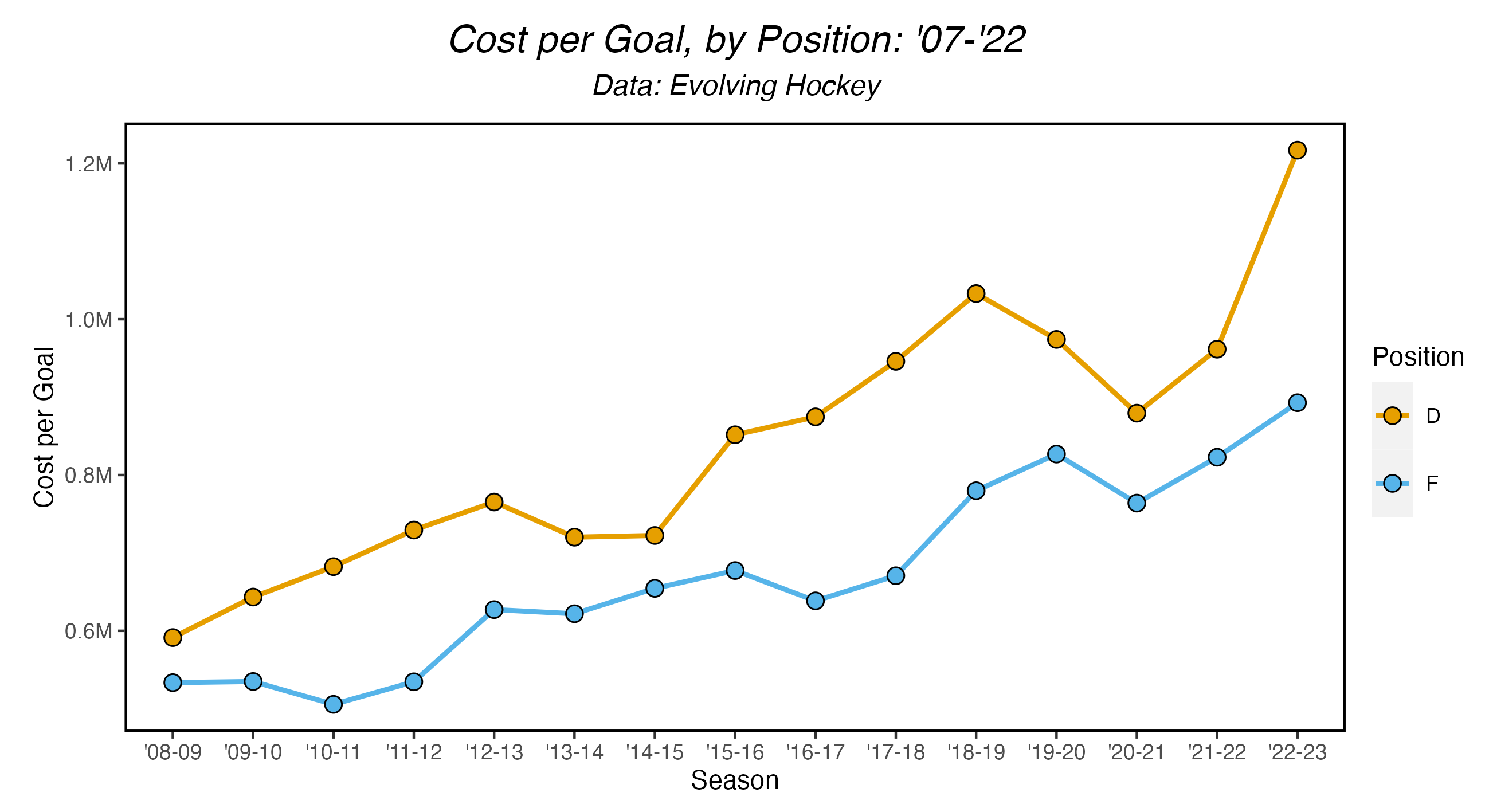
This shows the cost of buying 1 goal above replacement for each position. Of note, we see a consistent increase in the cost of goals season-over-season. The main reason for this is the rising cap since 2007; the salary cap has increased over $30 million since then. We see an interesting course correction, however, during the “flat cap era”. From 2018 to 2023, the salary cap increased by only $4 million, staying at a flat $81.5 million for three of those seasons. The decline around the ’18-19 season and subsequent “flat” nature for the next few seasons seems to reflect the slowing increase in salary cap over this span. However, with rumors of an imminent increase to the salary cap in the coming seasons, it seems teams have started anticipating this with an increase in money they are willing to spend on players.
The salary cap isn’t the only thing causing the increase here. Notably, we have seen quite a few hefty contracts recently handed out, specifically, to defensemen whose performance has been less than superb according to our GAR model (Erik Gudbranson, Ben Chiarot, John Klingberg, Tony DeAngelo, Jérémy Lauzon to name a few). Recently, GMs have, on average, paid the same or more money for worse performance from defensemen. With these contracts handed out, the market has shifted: it theoretically now costs “more” to buy goals from defensemen due to these recent contracts (based on our GAR model). To put it another way, if GMs had been paying the same or less money for better performance, the cost of a goal would have decreased. Now, there are a lot of caveats here that I’ll have save for another article. We’re also dealing with a fairly limited amount of data here; it’s entirely possible last summer/season was an outlier and a shift in the opposite direction is on the horizon. Either way, I’m not entirely sure this free agency class will change things too much.
To summarize: We have a contract projection model and a Goals Above Replacement projection model on Evolving Hockey. We can convert our GAR numbers into dollar values using some nifty math borrowed from the baseball community. Using this newly converted GAR dollar value, we can compare projected contracts for players to their respective projected GAR values heading into the next season. Here I thought I could explain this a little quicker, but, alas, I’ve never been able to do that in my life. Let’s move on to the actual comparison.
Player Evaluation
Let’s take a look at the raw comparison between our projected contract value and projected GAR values:
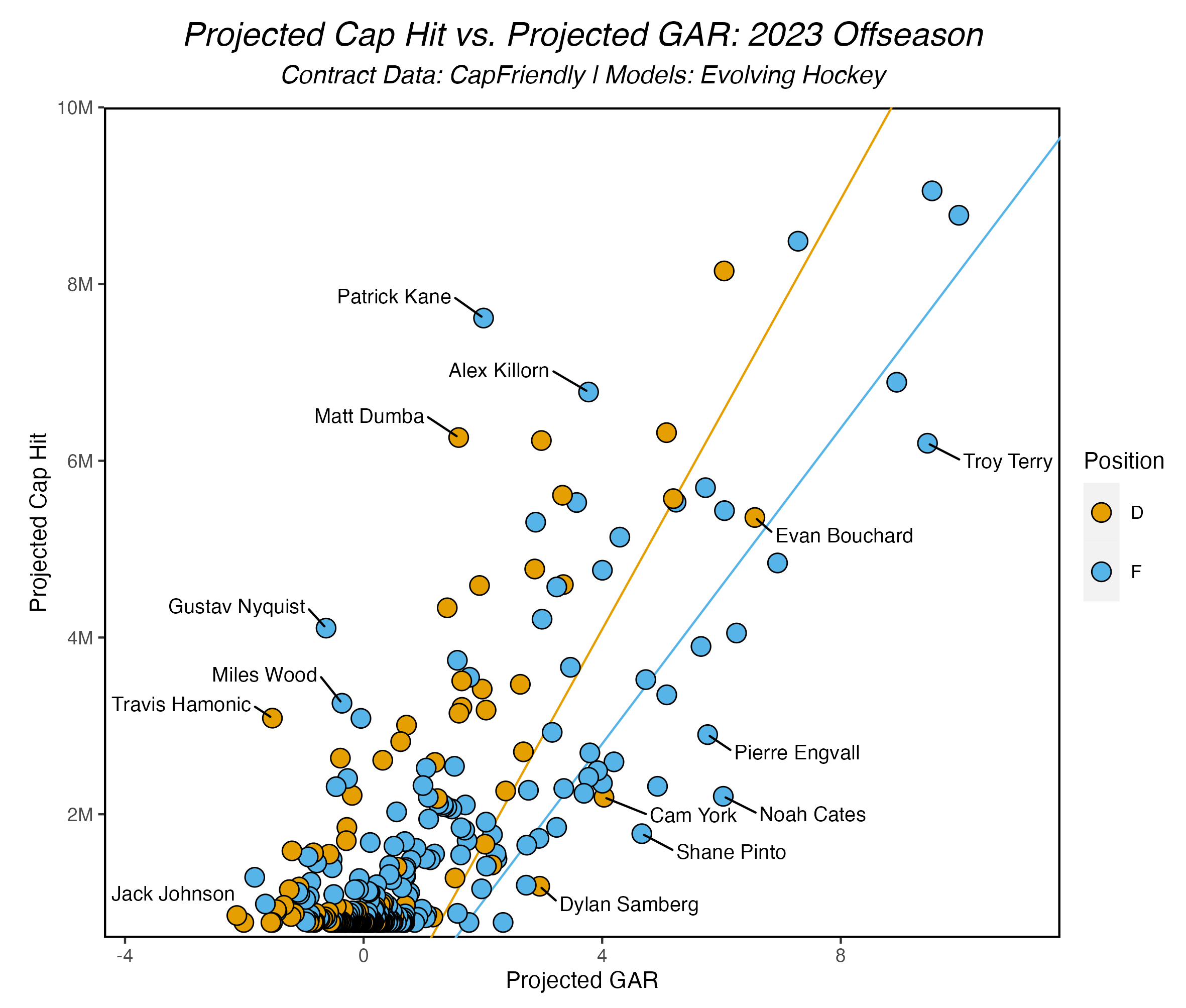
Each line represents the respective cost per goal values for each position. Players that fall on the “right” side of the line here are potentially under-valued when comparing their projected contract to their projected on-ice performance value heading into next season, and vice versa. I’ve labeled a few outlier players that I’ll be covering below.
This offseason is markedly different from last year. Mainly, the 2023 free agency class (especially the UFA players available) is surprisingly thin. Last year, we projected nine UFA players to sign contracts at or over $7M per year. This year, the model is only projecting one, and that one comes with a fairly big asterisk due to non-model narrative aspects (Patrick Kane, who I assume will likely not be getting what we project). All the top free agents are RFAs this year, and only one is projected over $9M per year (DeBrincat). Additionally, we’ve already seen a decent amount of big-$ contracts signed before free agency has even begun, which not only removes players from the available player pool, but also impacts how players may be paid once free agency begins. Given that we do not re-train our contract projection model with recent contracts signed before free agency, it’s possible we may be missing a few important comparables in the coming weeks. Or, it could just be a standard June pre-free-agency period. We’ll find out soon enough. With all that said, let’s get into it.
Once again, I’m using the same method I used last year for this evaluation. If you’d like a refresher on how this works, please reference the “Calculating Expected Free Agent Value” section in last year’s preview article. One thing to keep in mind is that our GAR projections have uncertainty values built in, which allows us to project both our “expected” value and a range of low and high estimates for what one may expect for each player as well.
Best Value: UFAs
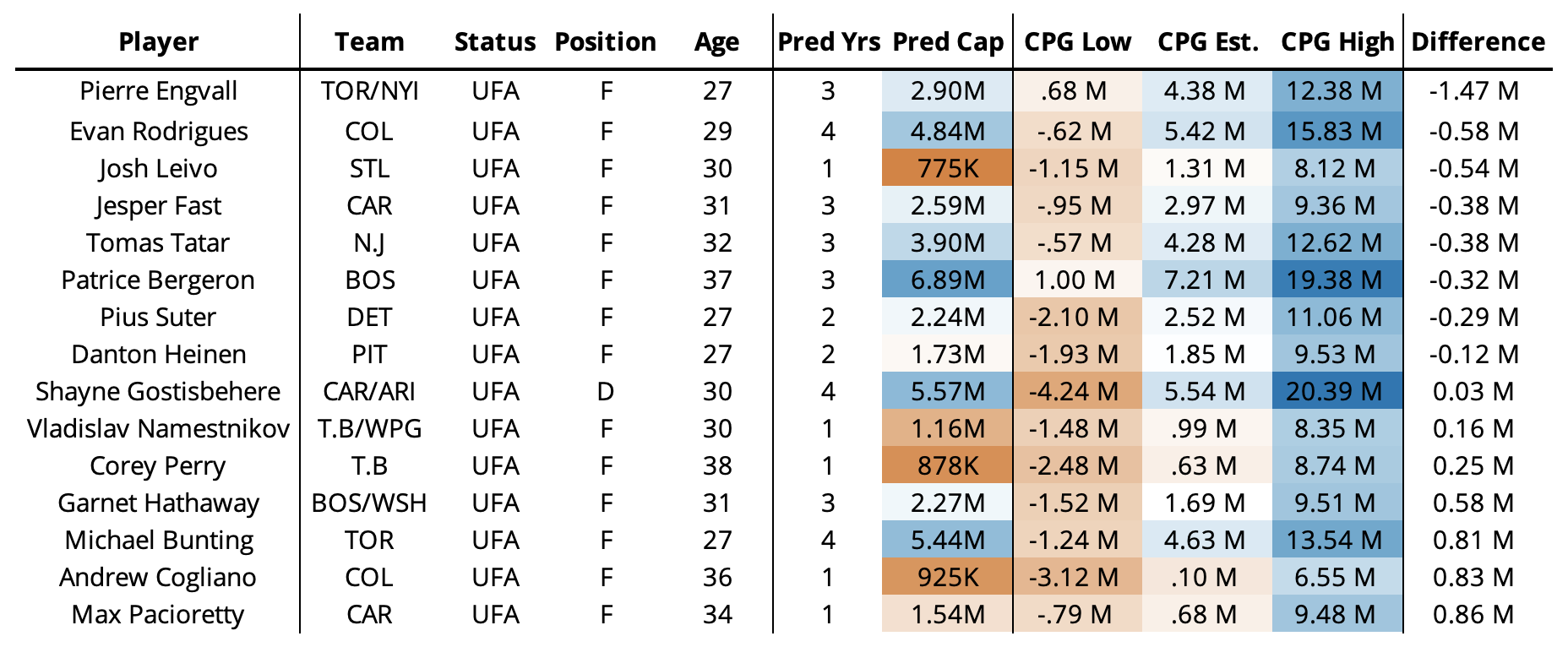
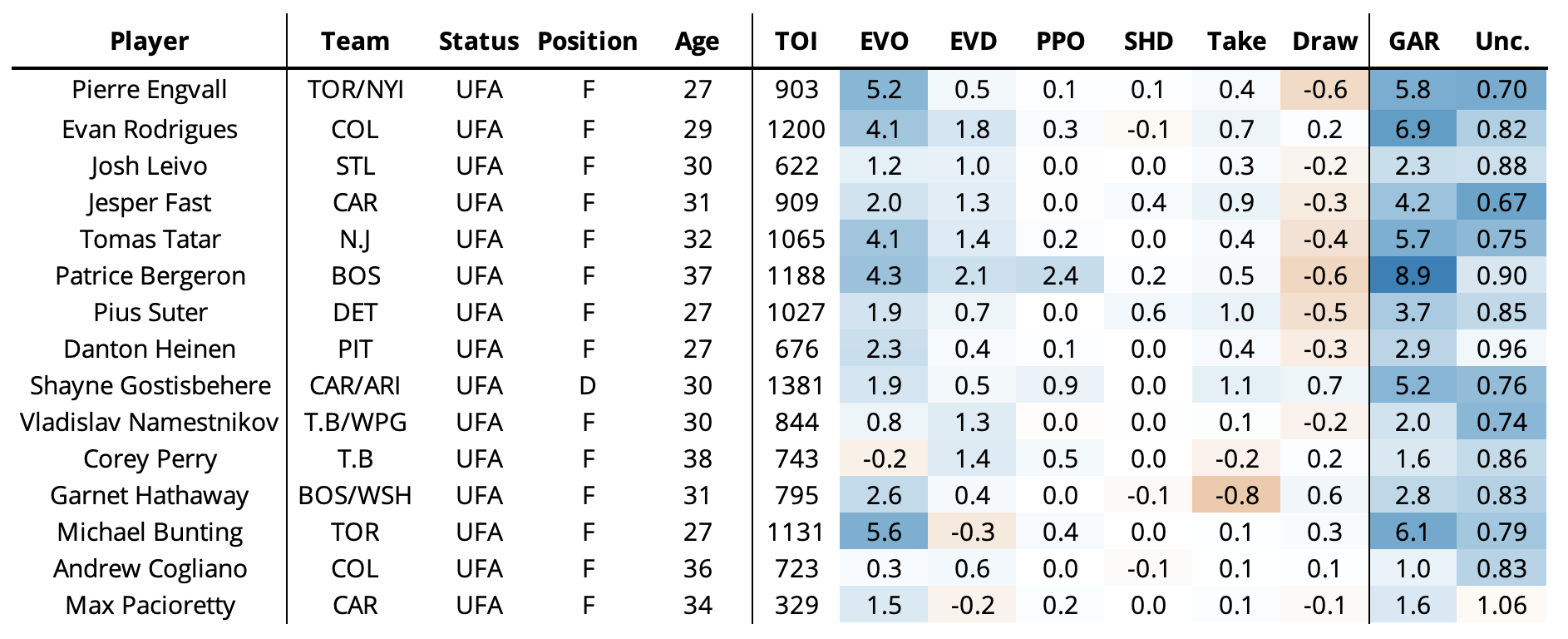
This year’s crop of UFAs is something. It’s not that any of the players here are bad, necessarily, it’s that there aren’t any players a team might consider a “star”. Usually in a free agency class, we’ll see a good group of prime players that teams might hope to sign and slot in at the top of their lineup. The fun part, usually, is finding players (like those above) that go overlooked during the summer. This year, we get the pure stats darlings and few others (I’m ignoring Bergeron). Like last year, we see a heavy emphasis on expected defensive value. Only two of the UFAs here project to be below replacement defensively at even-strength, and several could provide some very solid defensive contributions in depth roles. This is a trend we’ve noticed for a few years now, and smart teams tend to take advantage of this market discrepancy. The trick is figuring out which defensive players are “real”.
At the top we have Pierre Engvall, who actually projects to be a borderline top-100 player heading into next season based on our GAR projections. Engvall was great last season and adds solid value all around at even-strength. He’s not a guy most teams would slot in the top-6 or on the powerplay, but as a depth 3rd liner, he could be a great add for any team looking to bolster their depth with some solid two-way play (an Evolving Hockey guy [tm]).
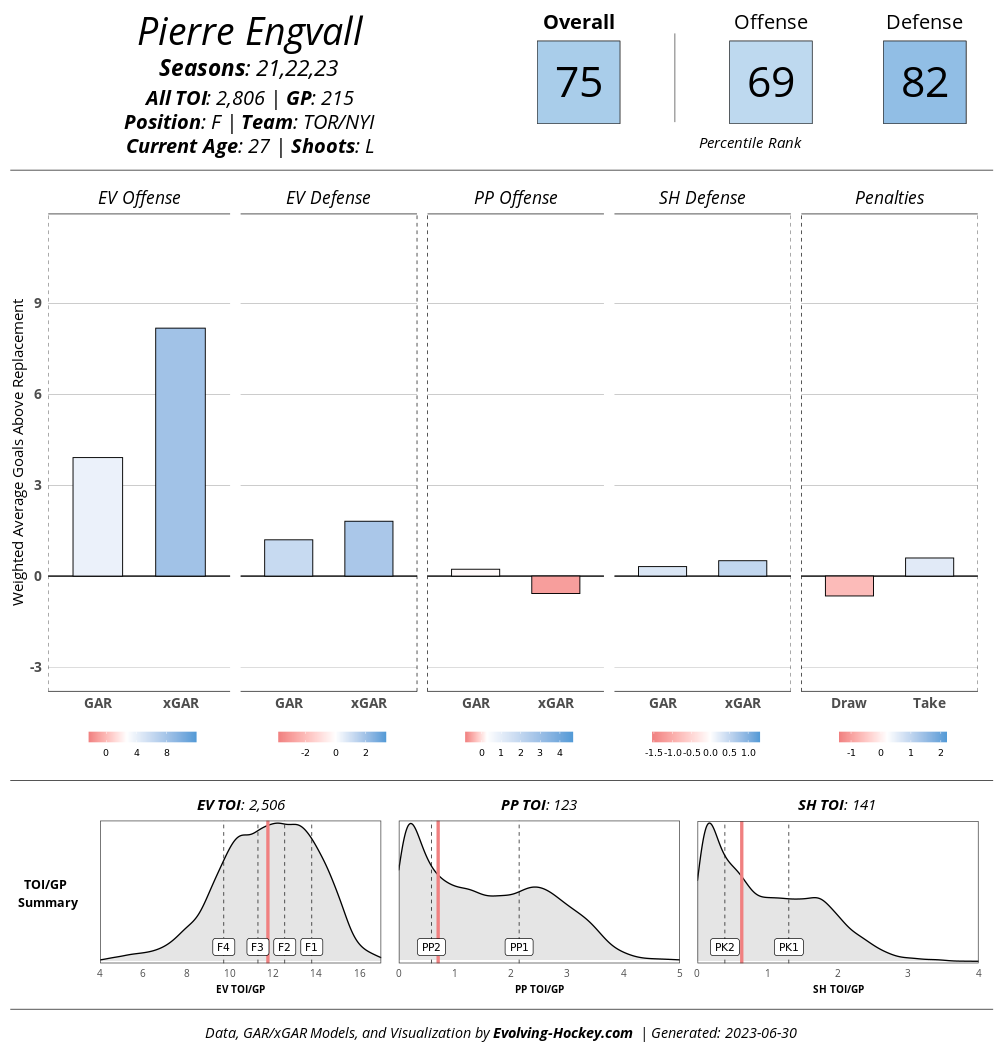
Maybe the most interesting free agent is Tomáš Tatar. Per our GAR model, since he entered the league, Tatar has only posted a below-replacement level season once (’21-22). He bounced back heavily with New Jersey this past season, and it wouldn’t surprise me if the Devils consider bringing him back. Even at 32, Tatar is quite good, and given this year’s free agency class, he might be the most sought-after unrestricted free agent for a team looking for potential top-6 talent.
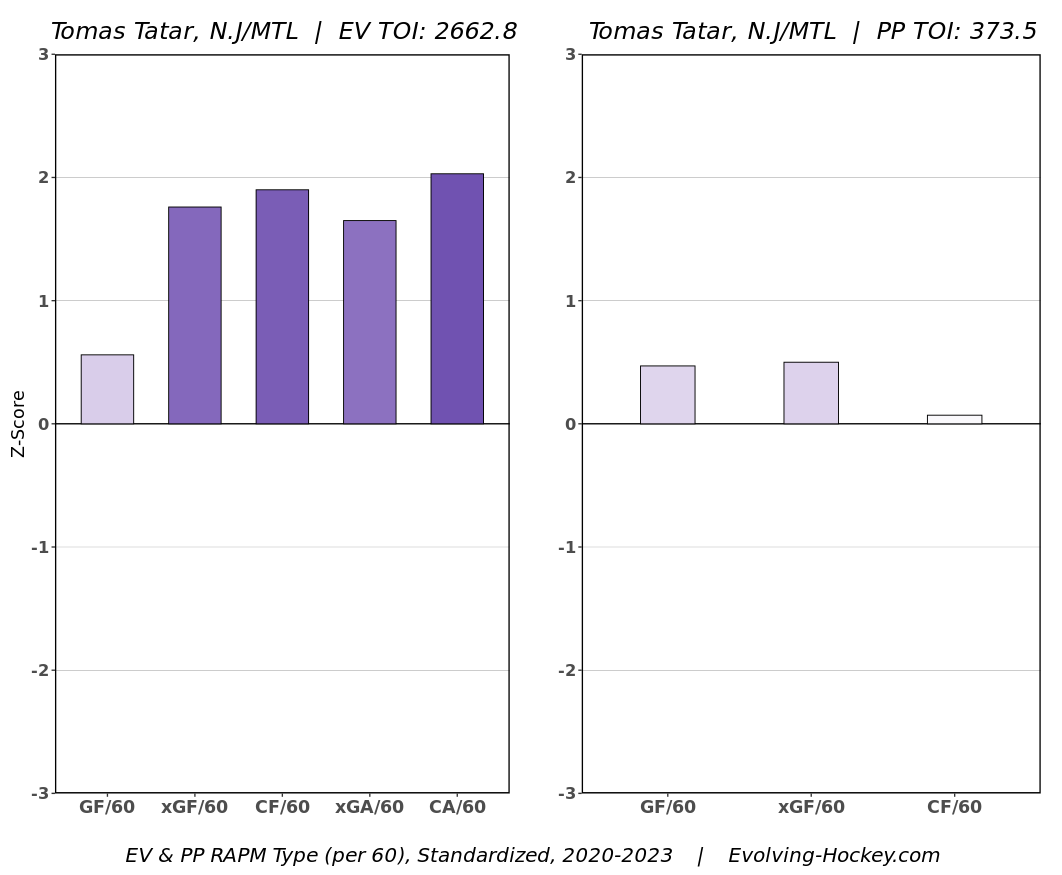
Among the UFA defensemen available, there really isn’t much of a choice. Shayne Gostisbehere is easily the best D. He’s bounced around a few teams over the past three seasons, and his usage has changed as he’s gotten older, but few defensemen have continuously performed above replacement while overlooked in older age the way Ghost has. He’s certainly not a slam dunk for any team, but as a potential top-4 regular with powerplay upside, he’s a defensemen most teams (whether they know it or not) would be happy to add this summer given the players available.
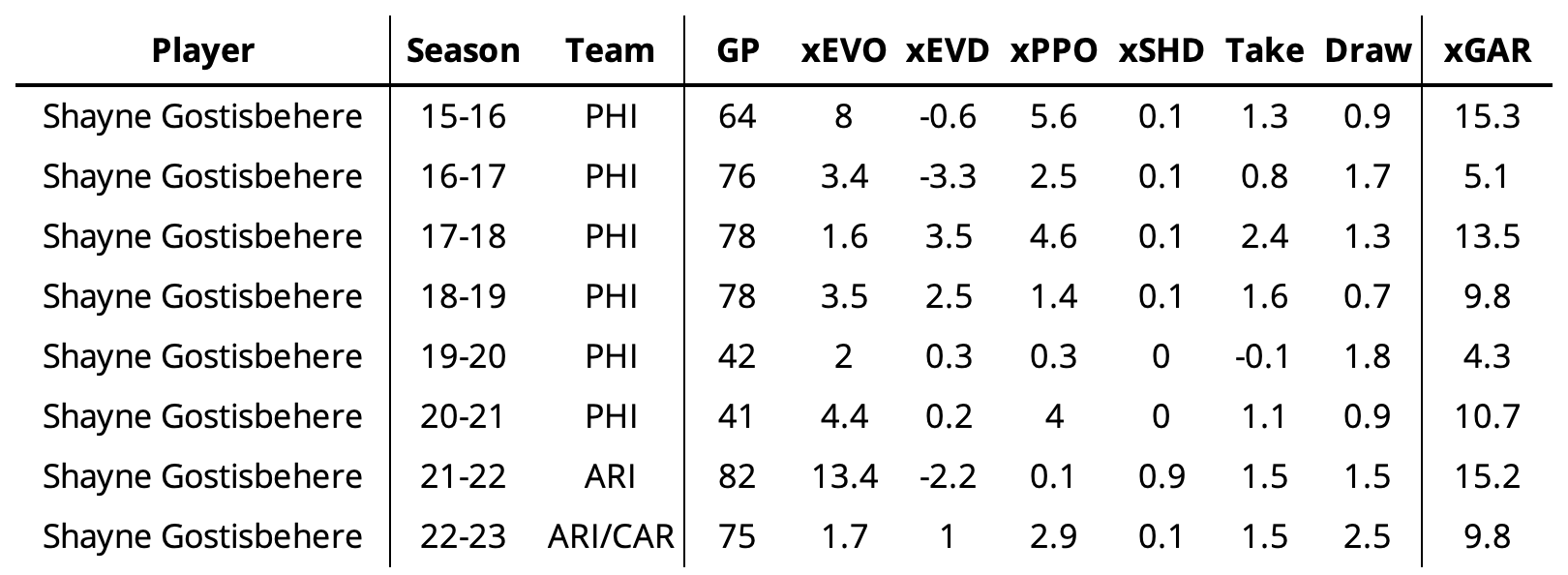
Best Value: RFAs

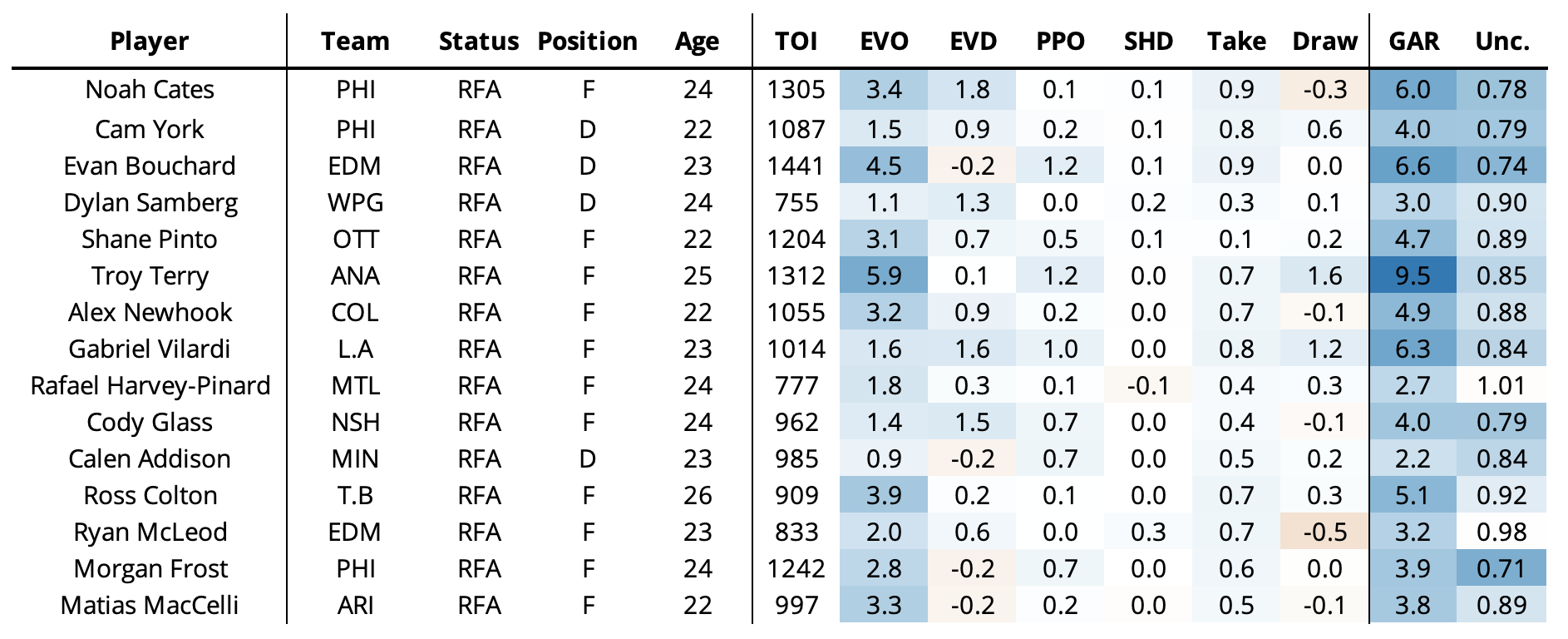
Noah Cates #1? Alright, now we’re talking. This year’s RFA class is quite a bit different than the UFAs for several very different reasons. But a few of the well-known young free agents are missing from the above tables (DeBrincat, Zegras, Dunn, among others). Usually, this is the case for most of the marquee free agents: if you’re very good, the market knows you’ll get a lot of money, which decreases the ability for your contract to be “good value”. This doesn’t make these players bad players to sign, it’s quite the opposite. Teams need these players to succeed, but the market for them is already set and in line. I’m not talking about Matthew Tkachuk, who had the 2nd highest projected contract last offseason and still ranked as the 6th most valuable signing in our preview. Kid’s a freak. Regardless, I’m just going to call it right now in (online) print: we’re going to see some bridge deals this offseason, and certain fanbases are not going to be happy.
Back to Noah Cates. Maybe something weird is going on in Philly […], but the Stillwater, MN native was among the best defensive forwards in the league last season per several of our models. He’s heading into his third season in the NHL, but, so far, he’s been extremely good. On a bridge deal, he ranks as the best value player among all free agents this summer. Who knows what the Flyers are really doing right now, but this contract may be the most sign-this-right-now contract among any free agent. Love this kid, the perfect hockey player.
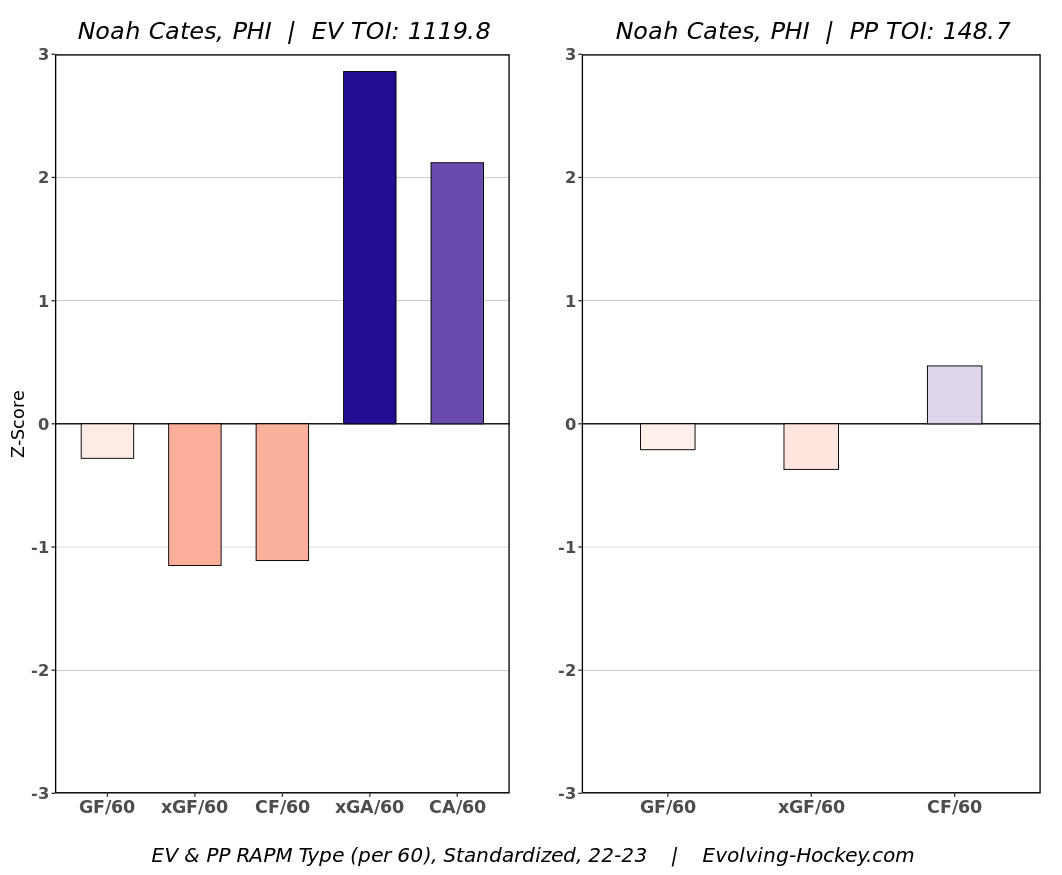
Evan Bouchard is sneaky good. He had a great season last year, and his playoff performance seems to have turned some people on to his abilities. Of all free agent defensemen, Bouchard leads the pack in our GAR projections (Vince Dunn is close behind). He’s excelled with the Oilers in the past two seasons, and no defensemen up for a new deal carries the all-around game that he does. Now, he has played a lot of time with McDavid and Draisiatl, and I think it’s fair to be skeptical about his expected value on another team if you think he’s being carried. But every other area of his game is there – it’s not just the powerplay. I’m surprised Edmonton hasn’t signed him already (well, not that surprised).
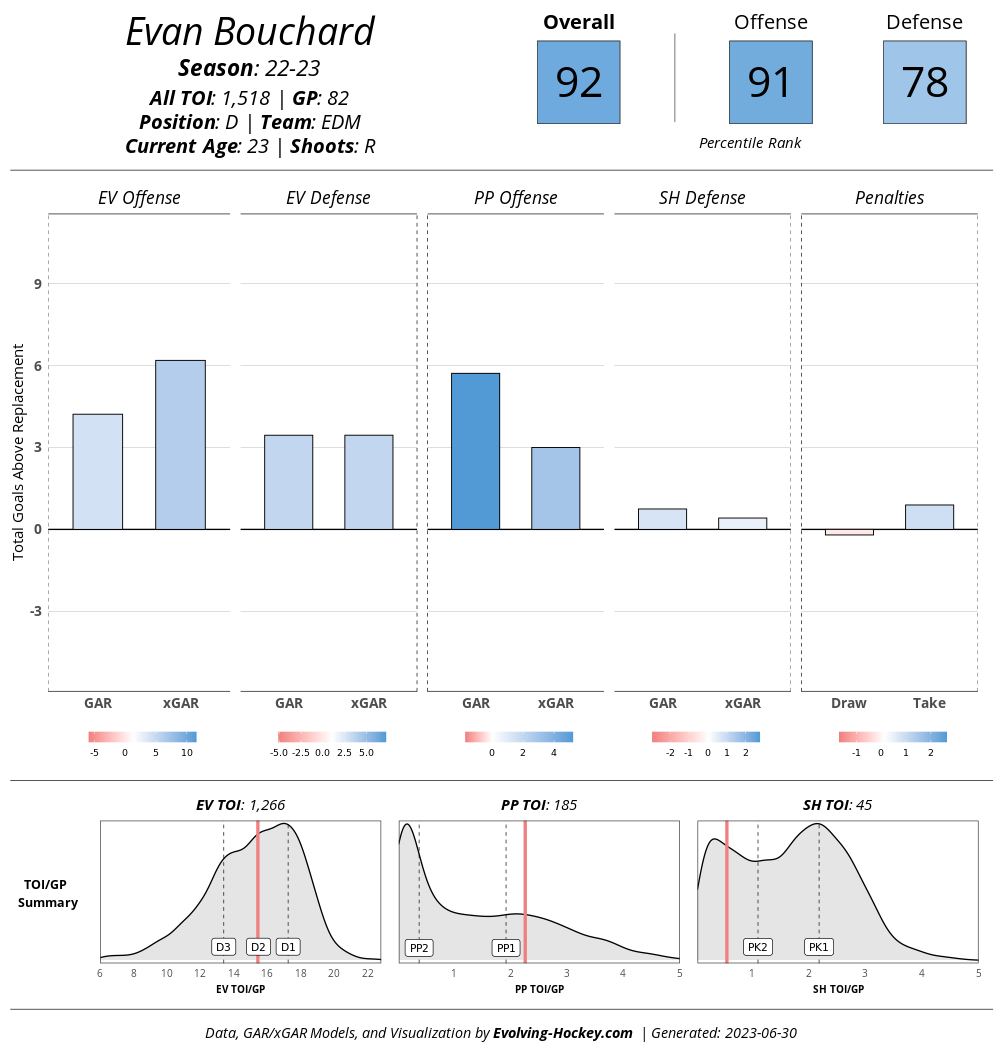
The Winnipeg Jets acquired Gabriel Vilardi along with Alex Iafallo in a recent deal that sent Pierre-Luc Dubois to the Los Angeles Kings. While Dubois is the better player right now, Vilardi is shaping up to be a future star. He’s been fantastic in limited time over the past four seasons, and the 23 year old ranked 3rd among all Kings’ skaters in Expected Goals Above Replacement last year. Once again, a ton of his both expected and previous value has come from defense, but his ability to generate high-danger shots is exceptional. It’s pretty fair to assume Winnipeg will be signing Vilardi, and it stands to reason that they couldn’t have done much better in their return for Dubois. Vilardi is someone to watch.
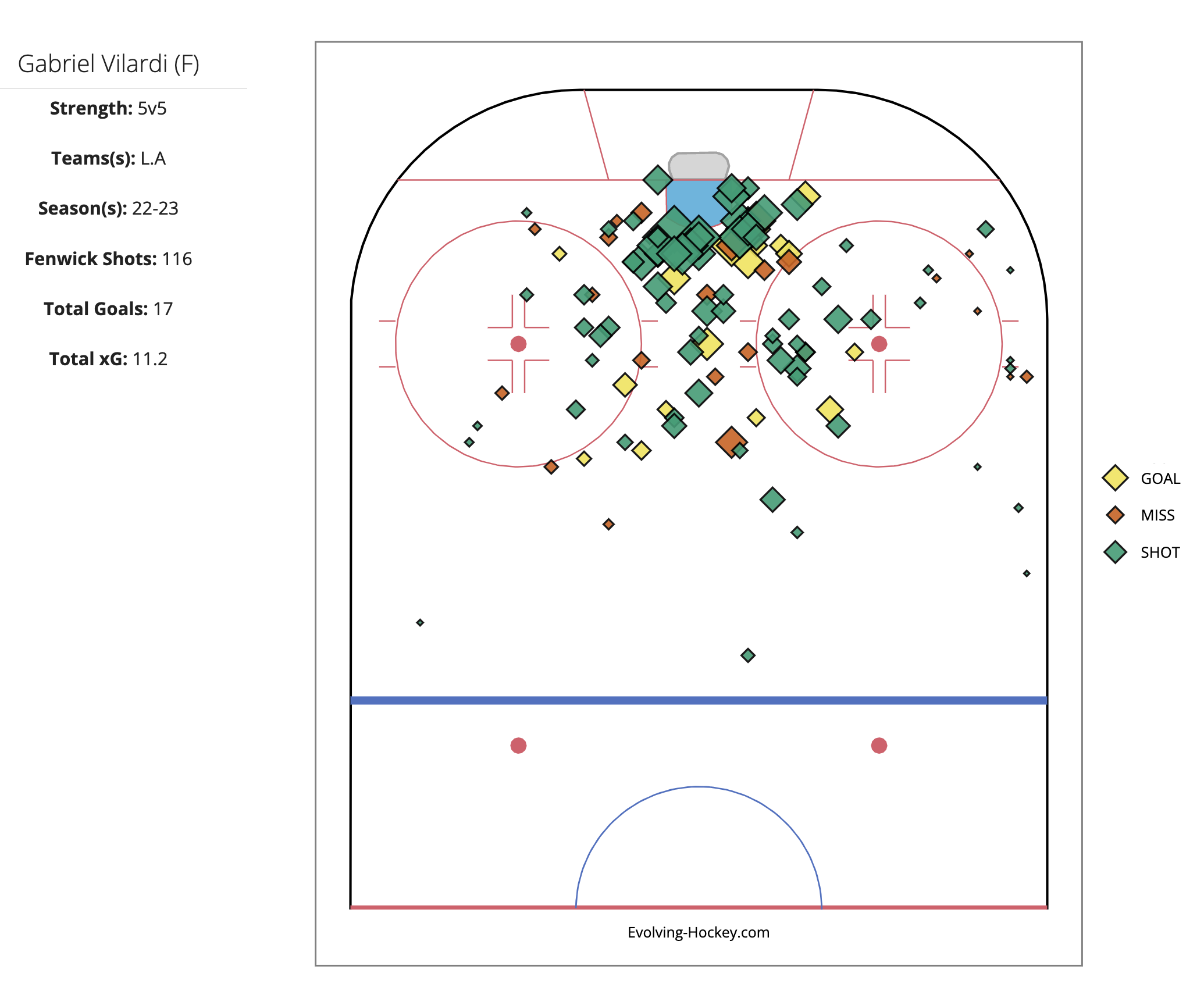
Worst Value: All Contracts
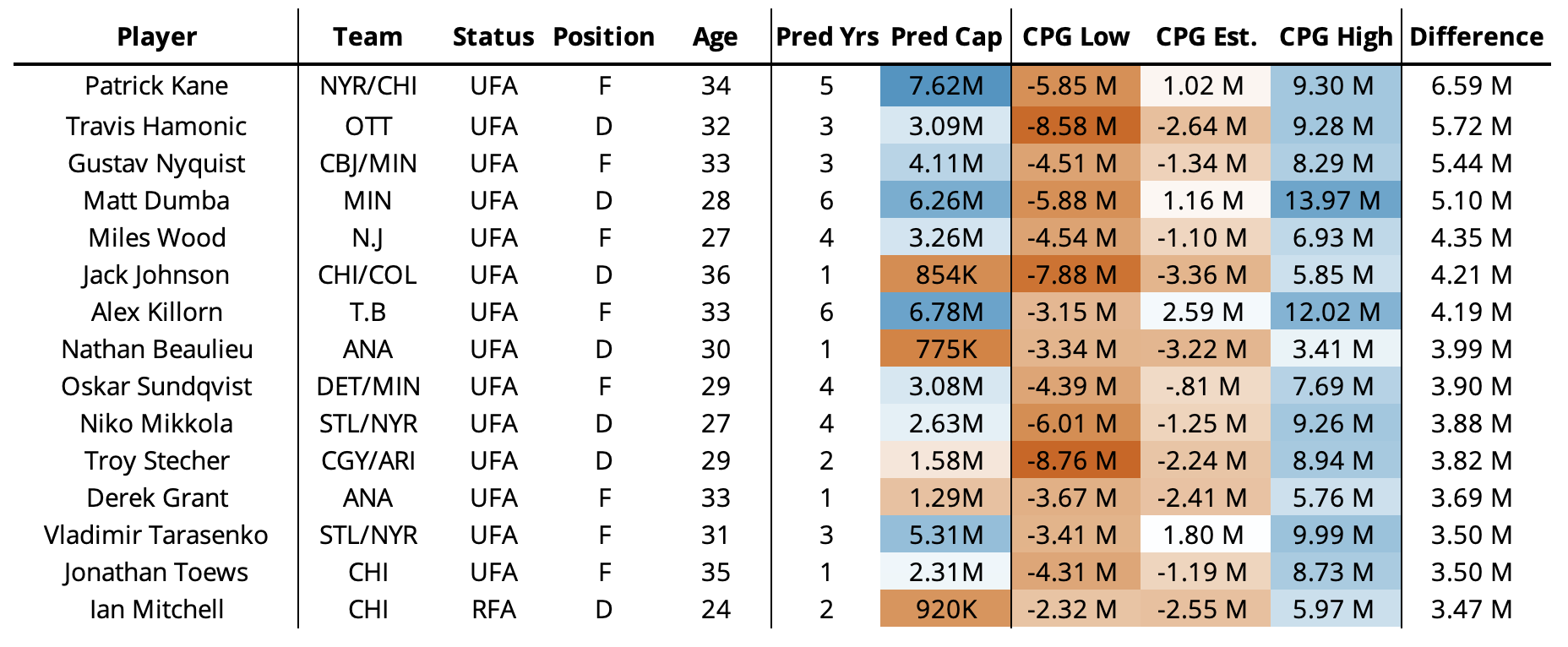
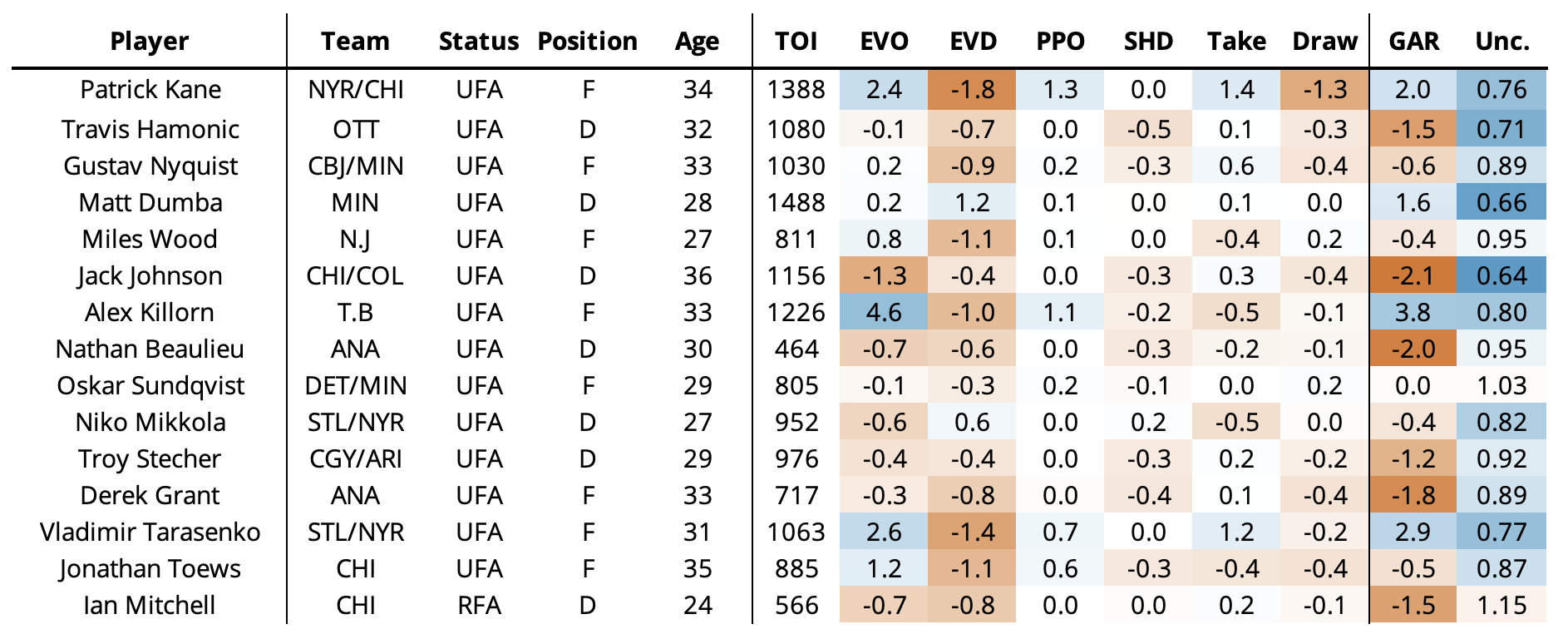
As is tradition around these parts, we have to show the flip side. I’m not going to spend too much time on this, but here are the contracts that will likely be the most overvalued heading into the summer. We’ve already talked about Kane, but a few others stand out. Given the defensemen deficient market, it stands to reason that Matt Dumba’s projection here may be in line with what he’ll get on the open market. Oddly, he tends to be seen around the league as an all-offense potential powerplay D with a good shot, but his value, at least based on our models, lies more in his defensive play. I’m not sure I believe that, but that’s what the models say so it can’t be wrong. Jack Johnson continues to get contracts and continues to find himself in these tables, so who is wrong (it’s us I guess?).
Alex Killorn may be the most interesting player in the entire class. The 33 year old has a long, solid history with Tampa, so the pedigree is there. Per our xGAR model, he had his best season in four years last year, and still likely brings solid offensive abilities to any team that signs him. The issue, likely, is his age, high projected contract value, and basically everything else. If a team can get him for (much) less, he could be quite a valuable addition, but that seems unlikely given this summer’s free agency class.
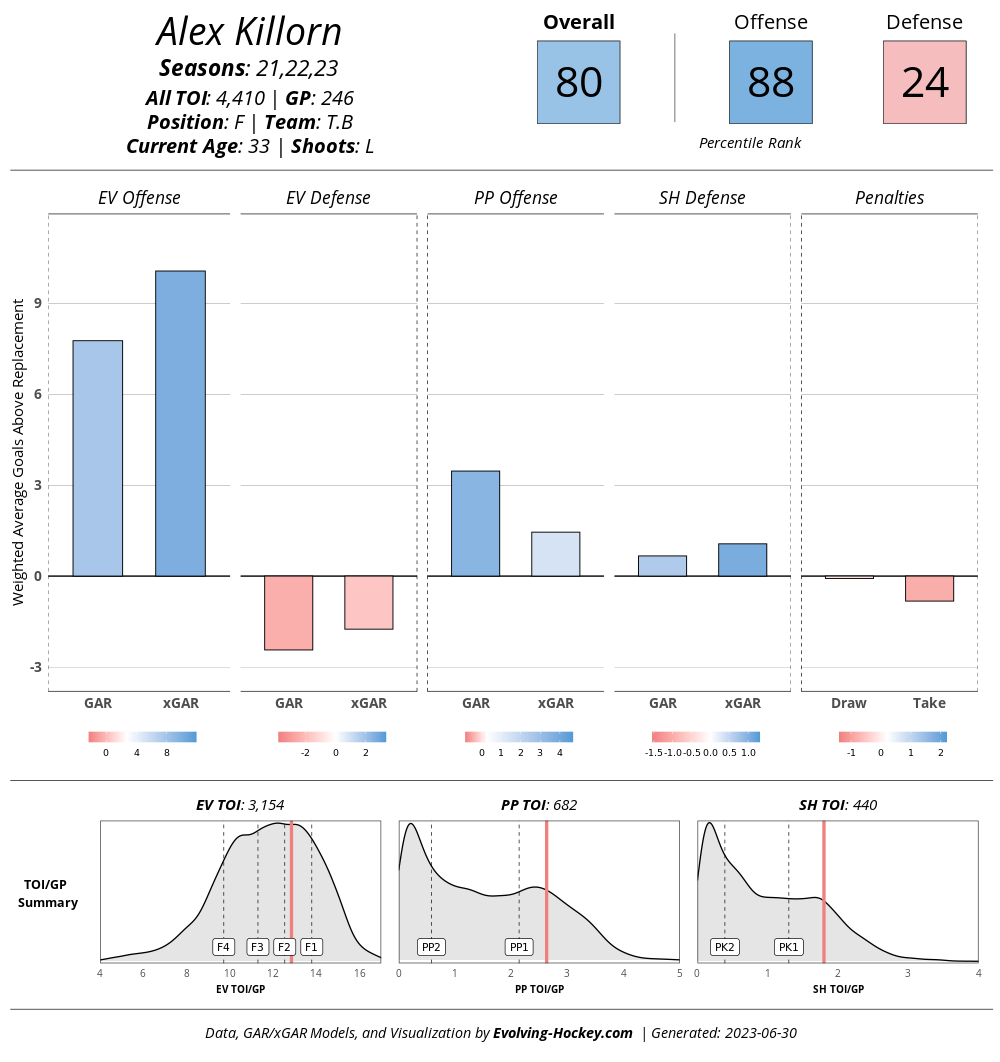
Wrapping Up
This summer will be anything if not interesting. Given the ridiculous lack of big-name free agents, teams will likely be doing things. Will those things be good? They might be. For several cap-strapped contenders, signing your RFAs and doing nothing else seems like a very efficient option. Others will be looking for ways to get valuable players on solid deals, and there are definitely players available that fit the bill. If the past month is any indication, I think we’re in the middle of a small sea change in the market. Next year’s free agency class is out of control, the rumors around the rising cap are already impacting how teams and players are negotiating contracts, and teams gotta win. Let’s get crazy (not really, our models like stability and we hate being wrong).
